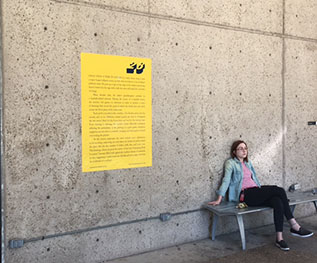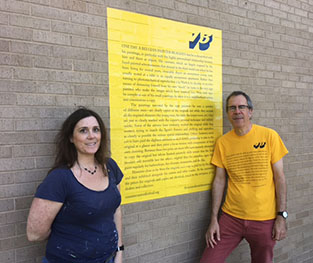

Look up, look down, look all around and you can’t miss the bright yellow vinyl panels with text plastered all over the University of Houston campus. “Coog’s House” has transformed into a canvas for a public art installation called “The Miraculous: Houston”.
“The Miraculous: Houston” is a larger-scaled version of the book “The Miraculous” by Raphael Rubinstein, professor of critical studies in the Kathrine G. McGovern College of the Arts. It contains 50 micro-narratives about the lives and works of contemporary performance and conceptual artists.
Heather Bause, a former UH painting instructor and alumna, came up with the concept to take all 50 episodes of the book and strategically “explode” them across campus. Anyone who walks around is likely to encounter these situations on a sidewalk, a bench and the side of a building. Some texts are hidden away in certain places and will require the curious to go on a treasure hunt.
Q. What makes this installation unique?
Rubinstein: There are no performative aspects about this even though much of the art that I talk about is performance. The book is a sort of history of unconventional performance and conceptual art. It’s different because it’s going to be on view for the public, including people from the Houston art audience who will come and search out these episodes in their various art locations.
Q. What is the significance of using the UH campus for these works?
Bause: Many of the artists in the book performed their acts in public spaces and this is a very public university. By dispersing the pages of this book across the campus, students will be taken out of their daily routine and hopefully walk to parts of campus they had no idea existed.
Q. What do you hope people will get out of reading these episodes?
Rubinstein: This is a book that can be accessible to people who don’t really know anything about art and they might relate to it as just incredible stories. I would like them to think that art can be found anywhere. It’s not just in museums. It’s not just in galleries. It’s not just by artists. Everyone potentially can become an artist.
Bause: I am really curious to hear what people think. It’s not just putting pages of a book on the wall, it’s sharing with students, faculty and staff these really profound moments in these subjects’ lives.
“The Miraculous: Houston” will remain on campus until mid-October. Maps showing locations of the pieces will be available around campus, as well as on The Miraculous: Houston website.